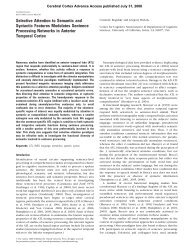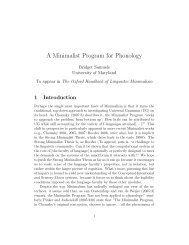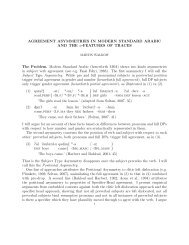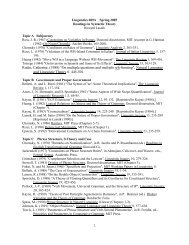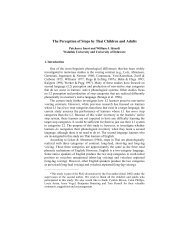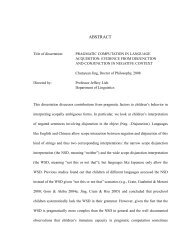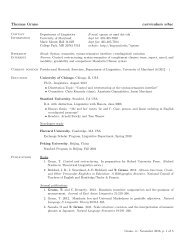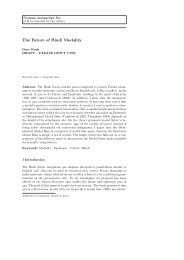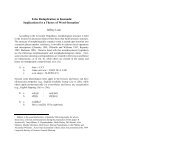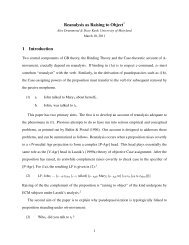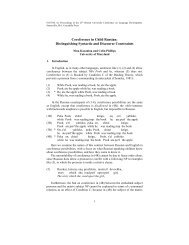âStabilityâ of vowel categories is grounded in phonology - Linguistics ...
âStabilityâ of vowel categories is grounded in phonology - Linguistics ...
âStabilityâ of vowel categories is grounded in phonology - Linguistics ...
You also want an ePaper? Increase the reach of your titles
YUMPU automatically turns print PDFs into web optimized ePapers that Google loves.
“Stability” <strong>of</strong> <strong>vowel</strong> <strong>categories</strong> <strong>is</strong> <strong>grounded</strong> <strong>in</strong> <strong>phonology</strong>:<br />
Evidence from Engl<strong>is</strong>h dialect compar<strong>is</strong>on<br />
Mathias Schar<strong>in</strong>ger a , William J. Idsardi a<br />
a Department <strong>of</strong> L<strong>in</strong>gu<strong>is</strong>tics, University <strong>of</strong> Maryland, USA<br />
Correspond<strong>in</strong>g author:<br />
Dr. Mathias Schar<strong>in</strong>ger<br />
Department <strong>of</strong> L<strong>in</strong>gu<strong>is</strong>tics<br />
University <strong>of</strong> Maryland<br />
College Park, MD 20742-7505<br />
Tel.: +1-(301) 405-3127<br />
Fax: +1-(301) 405-7104<br />
Email: mts@umd.edu<br />
<br />
1
ABSTRACT<br />
Current models <strong>of</strong> speech perception emphasize either f<strong>in</strong>e-gra<strong>in</strong>ed acoustic properties or coarsegra<strong>in</strong>ed<br />
abstract character<strong>is</strong>tics <strong>of</strong> speech sounds. Here, we provide evidence for the view that<br />
<strong>vowel</strong> <strong>categories</strong> are <strong>grounded</strong> <strong>in</strong> abstract phonological representation and that these<br />
representations account for the successful access <strong>of</strong> the correspond<strong>in</strong>g <strong>categories</strong>. In an auditory<br />
semantic prim<strong>in</strong>g experiment, American Engl<strong>is</strong>h l<strong>is</strong>teners made lexical dec<strong>is</strong>ion on targets (e.g.<br />
pot) preceded by semantically related primes (e.g. pan). A variation <strong>of</strong> the prime’s <strong>vowel</strong> across<br />
<strong>categories</strong> (e.g. pen) was not tolerated, as assessed by a lack <strong>of</strong> prim<strong>in</strong>g, although the phonetic<br />
<strong>categories</strong> <strong>of</strong> the two different <strong>vowel</strong>s considerably overlap. Compared to the outcome <strong>of</strong> the<br />
same experiment with New Zealand Engl<strong>is</strong>h l<strong>is</strong>teners, where prime variations were tolerated, our<br />
experiment supports the view that phonological, but not phonetic representations guide the<br />
mapp<strong>in</strong>g process from the acoustic signal to an abstract mental representation.<br />
ACKNOWLEDGMENTS<br />
Th<strong>is</strong> research was supported by National Science Foundation Grants XXX. We thank Yakov<br />
Konrod, Alan M<strong>is</strong>hler, and Alex<strong>is</strong> Wellwood for their help <strong>in</strong> the data acqu<strong>is</strong>ition.<br />
KEYWORDS<br />
Speech perception, phonetic vs. phonological <strong>categories</strong>, <strong>vowel</strong> representations, semantic<br />
prim<strong>in</strong>g, lexical dec<strong>is</strong>ion<br />
<br />
2
Introduction<br />
Engl<strong>is</strong>h <strong>vowel</strong>s show substantial variation <strong>in</strong> pronunciation across speakers. Th<strong>is</strong> can ar<strong>is</strong>e from<br />
several factors, most prom<strong>in</strong>ently gender, dialect, and social background (e.g. Hagiwara, 1997;<br />
Johnson, 1997; L<strong>in</strong>dblom, 1990; Thomas, 2001). Vowel <strong>categories</strong> considerably overlap based<br />
on their first (F1) and second (F2) formant values (cf. Hillenbrand, Getty, Clark, & Wheeler,<br />
1995; Peterson & Barney, 1952), these measures be<strong>in</strong>g two salient acoustic cues for <strong>vowel</strong><br />
identification and categorization across languages (Flege, Munro, & Fox, 1994; Ladefoged,<br />
2001; L<strong>in</strong>dblom & Studdert-Kennedy, 1967; Pols, van der Kamp, & Plomp, 1969; Stevens,<br />
1998). Although <strong>vowel</strong> <strong>categories</strong> thus seem to be rather fuzzy and <strong>vowel</strong> perception has shown<br />
to be less categorical than (stop) consonant perception (P<strong>is</strong>oni, 1973; Schouten & van Hessen,<br />
1992), subjects can nevertheless d<strong>is</strong>t<strong>in</strong>gu<strong>is</strong>h <strong>vowel</strong>s <strong>in</strong> close vic<strong>in</strong>ity (such as [] and []) with<br />
high accuracy (Hillenbrand et al., 1995). Here we report further evidence that overlapp<strong>in</strong>g <strong>vowel</strong><br />
<strong>categories</strong> <strong>in</strong> Standard American Engl<strong>is</strong>h (henceforth AE) do not cause perceptual ambiguities <strong>in</strong><br />
a behavioral onl<strong>in</strong>e task. The results are compared to previous f<strong>in</strong>d<strong>in</strong>gs from New Zealand<br />
Engl<strong>is</strong>h (NZE, Schar<strong>in</strong>ger & Lahiri, 2010), where a substantial shift <strong>of</strong> <strong>vowel</strong> <strong>categories</strong> <strong>is</strong><br />
observed. As illustrated <strong>in</strong> more detail below, we suggest that the underly<strong>in</strong>g phonological<br />
system determ<strong>in</strong>es the stability <strong>of</strong> <strong>vowel</strong> <strong>categories</strong>.<br />
Theoretical background: Phonetic vs. phonological variation<br />
Some Engl<strong>is</strong>h varieties show a degree <strong>of</strong> dialectal variation which shifts certa<strong>in</strong> <strong>vowel</strong>s across<br />
categorical and phonological boundaries. An example <strong>is</strong> provided by the short front <strong>vowel</strong>s <strong>of</strong><br />
NZE. Here, orig<strong>in</strong>al low [] moved to the mid position <strong>of</strong> [], while [] moved to the position <strong>of</strong><br />
<br />
3
high [] (Gordon, Maclagan, Hay, Campbell, & Trudgill, 2004; Langstr<strong>of</strong>, 2006). Figure 1<br />
illustrates the pronunciation consequences for the nouns pan, pen, and p<strong>in</strong> <strong>in</strong> compar<strong>is</strong>on to AE.<br />
The column ‘lexical set’ refers to a dialect-<strong>in</strong>dependent label <strong>of</strong> the respective <strong>vowel</strong>s (Wells,<br />
1982). We conjectured that <strong>in</strong> order to correctly produce words with the TRAP <strong>vowel</strong> <strong>in</strong> NZE, the<br />
underly<strong>in</strong>g phonological representation must have shifted, too (cf. Figure 1). Note that we<br />
consider the phonological representation as what may equal the d<strong>is</strong>tributional center <strong>in</strong> phonetic<br />
exemplar space. A change <strong>in</strong> phonological representation <strong>is</strong> not characterized by <strong>in</strong>creas<strong>in</strong>g<br />
overlap between phonetic <strong>categories</strong>, but rather <strong>in</strong> a shift <strong>of</strong> the category center. While changes<br />
<strong>in</strong> category overlap can be considered phonetic variation, shifts <strong>of</strong> category centers describe<br />
phonological variation (between dialects) or phonological change (with<strong>in</strong> dialects). Naturally,<br />
these k<strong>in</strong>ds <strong>of</strong> variation are not <strong>in</strong>dependent. Phonological variation implies phonetic variation,<br />
and phonetic variation can result <strong>in</strong> phonological variation as well.<br />
<br />
4
Figure 1: Phonetic realization <strong>of</strong> experimental stimuli <strong>in</strong> Schar<strong>in</strong>ger & Lahiri (2010) [NZE] and th<strong>is</strong> study<br />
[AE]. The top part shows the location <strong>of</strong> the <strong>vowel</strong>s from monomorphemic Engl<strong>is</strong>h nouns <strong>in</strong> the F1/F2 space.<br />
The bottom part illustrates the assumed phonetic and phonological categorizations. Lexical set labels are<br />
given <strong>in</strong> order to compare the <strong>categories</strong> across dialects. Accepted variants are determ<strong>in</strong>ed on the bas<strong>is</strong> <strong>of</strong><br />
feature conflicts as described <strong>in</strong> Lahiri & Reetz (2002) which are absent when the phonological<br />
representation has no specification for a given feature (here: low).<br />
<br />
5
We had previously approached the <strong>is</strong>sue <strong>of</strong> differences <strong>in</strong> process<strong>in</strong>g TRAP <strong>vowel</strong>s <strong>in</strong> NZE<br />
compared to AE by employ<strong>in</strong>g an auditory semantic repetition prim<strong>in</strong>g experiment (Schar<strong>in</strong>ger<br />
& Lahiri, 2010). Th<strong>is</strong> behavioral experimental technique has shown to reflect lexical<br />
organization and process<strong>in</strong>g (Forster, 1999). In our study, we measured the lexical dec<strong>is</strong>ion times<br />
on targets semantically related to nouns with the TRAP <strong>vowel</strong> (e.g. pot <strong>in</strong> relation to pan, cf.<br />
Figure 2). Aside from conditions <strong>in</strong> which the TRAP <strong>vowel</strong> noun (e.g. pan) was used as prime for<br />
pot, we also selected DRESS and KIT <strong>vowel</strong> primes (e.g. pen, p<strong>in</strong>). Note that all primes were<br />
produced by a NZE speaker and therefore conformed to the pronunciation illustrated <strong>in</strong> Figure 1.<br />
<br />
Figure 2: Experimental design <strong>of</strong> auditory semantic prim<strong>in</strong>g <strong>in</strong> Schar<strong>in</strong>ger & Lahiri (2010) and th<strong>is</strong> study.<br />
Prime variants are primes with different <strong>vowel</strong>s than the semantic primes. They are labeled with lexical sets<br />
as expla<strong>in</strong>ed <strong>in</strong> Figure 1. Semantic primes always conta<strong>in</strong> the TRAP <strong>vowel</strong>.<br />
<br />
6
Intrigu<strong>in</strong>gly, all three prime types resulted <strong>in</strong> significantly faster lexical dec<strong>is</strong>ion times on<br />
the respective targets compared to an unrelated control condition. We <strong>in</strong>terpreted these f<strong>in</strong>d<strong>in</strong>gs<br />
as evidence for representational differences <strong>of</strong> the TRAP <strong>vowel</strong> <strong>in</strong> NZE: The absence <strong>of</strong> the<br />
feature “low” allows for the mapp<strong>in</strong>g <strong>of</strong> a phonetically high <strong>vowel</strong> (as <strong>in</strong> NZE pen) onto the<br />
phonological TRAP category (cf. Figure 1), that <strong>is</strong>, NZE pen ([pn]) <strong>is</strong> a no-m<strong>is</strong>match to NZE pan<br />
(/pn/) <strong>in</strong> the term<strong>in</strong>ology <strong>of</strong> Lahiri & Reetz (2002). The successful mapp<strong>in</strong>g <strong>of</strong> pen to pan leads<br />
to facilitated lexical access <strong>of</strong> pan and therefore, its semantic relatives (e.g. pot). The results <strong>of</strong> a<br />
further experiment with the same phonetic stimuli presented to AE l<strong>is</strong>teners significantly differed<br />
regard<strong>in</strong>g the prime variants. Th<strong>is</strong> allowed for the conclusion that the phonological<br />
representation <strong>of</strong> the TRAP <strong>vowel</strong> <strong>in</strong> AE differed with regard to NZE. Crucially, its low<br />
specification particularly excluded mapp<strong>in</strong>gs from the high <strong>vowel</strong> variant, and consequently,<br />
prim<strong>in</strong>g was absent <strong>in</strong> th<strong>is</strong> condition.<br />
We conducted a similar experiment here <strong>in</strong> order to test whether the prim<strong>in</strong>g pattern was an<br />
artifact <strong>of</strong> the phonetic material (the NZE stimuli) or <strong>in</strong>deed the underly<strong>in</strong>g representation <strong>of</strong> the<br />
TRAP <strong>vowel</strong>. For that purpose, we employed the same prim<strong>in</strong>g design as illustrated <strong>in</strong> Figure 2,<br />
but used stimuli recorded from an AE speaker and AE l<strong>is</strong>teners as participants. We also plan to<br />
run the experiment with NZE l<strong>is</strong>teners.<br />
If it <strong>is</strong> <strong>in</strong> fact the phonological <strong>vowel</strong> representation that accounts for the prim<strong>in</strong>g pattern<br />
and not the dialect <strong>of</strong> the speaker, we expect that the prime variants are not accepted as<br />
exemplars <strong>of</strong> the TRAP category for AE l<strong>is</strong>teners and thus should not prime. Based on previous<br />
studies (Allen & Miller, 2001; Miller, 1995), we further expect a relatively clear extraction <strong>of</strong><br />
phonetic category labels for the <strong>vowel</strong> exemplars presented.<br />
<br />
7
Methods<br />
Experimental design<br />
The same 64 mono-morphemic nouns (mean length 3.25 segments, SD=0.43) as used <strong>in</strong><br />
Schar<strong>in</strong>ger & Lahiri, 2010 were recorded from a New England speaker <strong>of</strong> AE and d<strong>is</strong>tributed<br />
over four experimental l<strong>is</strong>ts <strong>in</strong> a Lat<strong>in</strong> Square design. Th<strong>is</strong> guaranteed that each subject heard a<br />
target only once while across subjects, each target could be paired with four different prime<br />
types: (1) TRAP <strong>vowel</strong> nouns (e.g. pan); (2) DRESS <strong>vowel</strong> nouns (e.g. pen); (3) KIT <strong>vowel</strong> nouns<br />
(e.g. p<strong>in</strong>) and (4) unrelated nouns (e.g. sense). There were 16 critical item pairs <strong>in</strong> each subject<br />
l<strong>is</strong>t together with 52 filler pairs, 34 <strong>of</strong> which had pseudo-words as their second (target) element.<br />
Pseudo-words were derived from ex<strong>is</strong>t<strong>in</strong>g Engl<strong>is</strong>h words by alter<strong>in</strong>g 1-3 segments. They were<br />
phonotactically legal and cross-checked by a native Engl<strong>is</strong>h speaker. All item pairs were pseudorandomized.<br />
Subjects & Procedure<br />
68 students <strong>of</strong> the University <strong>of</strong> Maryland (52% females, mean age 20, SD=2.7) participated for<br />
class-credits and were randomly assigned one <strong>of</strong> the four experimental l<strong>is</strong>ts. They were tested<br />
<strong>in</strong>dividually and familiarized with the experimental task <strong>in</strong> a practice session with 10 primetarget<br />
pairs not occurr<strong>in</strong>g <strong>in</strong> the ma<strong>in</strong> experiment. In both tasks, experimental items were<br />
presented pair-w<strong>is</strong>e, us<strong>in</strong>g the s<strong>of</strong>tware DMDX (Forster & Forster, 2003), and subjects had to<br />
provide a word/pseudo-word dec<strong>is</strong>ion on the second member <strong>of</strong> each pair (the target). In order to<br />
match the attribution <strong>of</strong> button presses to the study by Schar<strong>in</strong>ger & Lahiri (2010), right-handed<br />
<br />
8
subjects had to give word-responses by press<strong>in</strong>g J with their right <strong>in</strong>dex f<strong>in</strong>ger (pseudo-words:<br />
F), while left-handed subjects (N=2) were given the opposite <strong>in</strong>structions.<br />
First (=prime) and second (=target) member <strong>of</strong> each experimental pair were separated by 250 ms,<br />
and subjects could respond with<strong>in</strong> 2000 ms after target presentation. Reaction time measurement<br />
started at the onset <strong>of</strong> the target. The experiment, <strong>in</strong>clud<strong>in</strong>g a short brief<strong>in</strong>g and the practice<br />
session, lasted for about 15 m<strong>in</strong>utes.<br />
Results<br />
Subjects showed acceptable performance on the targets (6.3% wrong responses, 0.8% time-outs),<br />
although 4 subjects and 2 items had error-rates above 25% and were excluded from further<br />
analyses.<br />
The dependent measures accuracy (correct vs. <strong>in</strong>correct lexical dec<strong>is</strong>ion) and reaction times<br />
(as log values) were analyzed <strong>in</strong> Mixed-Effect Models (Baayen, Davidson, & Bates, 2008;<br />
P<strong>in</strong>heiro & Bates, 2000) with subject and items as random effects and prime type (TRAP, DRESS,<br />
KIT, control) as a fixed effect. For the accuracy analys<strong>is</strong>, we calculated a Mixed-Effect Logit<br />
Model (Agresti, 2002; Breslow & Clayton, 1993) and found a ma<strong>in</strong> effect <strong>of</strong> prime type []<br />
(Wald-z = -2.20, p < 0.05), reflect<strong>in</strong>g higher error rates for the DRESS primes compared to all<br />
other conditions.<br />
For the reaction time analyses, we additionally removed outliers with more than 2.5 SD from<br />
the mean (8.5% <strong>of</strong> the data po<strong>in</strong>ts). There was a ma<strong>in</strong> effect <strong>of</strong> prime type (F(3,747) = 3.76, p <<br />
<br />
9
0.05), reflect<strong>in</strong>g significant differences between the control and the TRAP <strong>vowel</strong> condition (cf.<br />
Table 1 & Figure 3).<br />
Table 1: Random and fixed effects for the Mixed Model on reaction times. Fixed effects are given <strong>in</strong> relation<br />
to the control condition. The p values were calculated us<strong>in</strong>g 10000 Markov Cha<strong>in</strong> Monte Carlo simulations<br />
(MCMC; Baayen, 2008).<br />
Random Variance Std.Dev. MCMCmean<br />
SJ (Intercept) 0.0177 0.1331 0.0970<br />
Item (Intercept) 0.0071 0.0845 0.0770<br />
Residual 0.0239 0.1545 0.1598<br />
Fixed Estimate Std. Error MCMCmean pMCMC t value p(>|t|)<br />
(Intercept) 6.8524 0.0301 6.8518 0.0001 227.8900 0.0000<br />
Prime Type: TRAP -0.0335 0.0152 -0.0340 0.0338 -2.2000 0.0280<br />
Prime Type: DRESS 0.0146 0.0153 0.0145 0.3616 0.9500 0.3404<br />
Prime Type: KIT 0.0042 0.0153 0.0036 0.8152 0.2700 0.7848<br />
In order to assess potentially confound<strong>in</strong>g factors, we paralleled multiple regression analyses<br />
by determ<strong>in</strong><strong>in</strong>g the best-fit mixed-model for reaction times (cf. Crawley, 2005) with the<br />
alternative fixed effects phonemic length <strong>of</strong> prime, phonemic length <strong>of</strong> target, frequency <strong>of</strong><br />
prime, and frequency <strong>of</strong> target (Cobuilt log frequencies from CELEX, Baayen, Piepenbrock, &<br />
Gulikers, 1995). As a result <strong>of</strong> th<strong>is</strong> procedure, the best-fit model <strong>in</strong>cluded the random effects<br />
subject and item and the fixed effects phonemic length <strong>of</strong> target and frequency <strong>of</strong> target <strong>in</strong> a fully<br />
factorial design. Only the <strong>in</strong>teraction phonemic length <strong>of</strong> target x frequency <strong>of</strong> target was<br />
significant (t = 6.57, p < 0.05). In particular, for low frequency targets, reaction times were faster<br />
with <strong>in</strong>creas<strong>in</strong>g target length. Th<strong>is</strong> <strong>is</strong> not surpr<strong>is</strong><strong>in</strong>g <strong>in</strong> an auditory prim<strong>in</strong>g design where<br />
<br />
10
dec<strong>is</strong>ions are made on the bas<strong>is</strong> <strong>of</strong> the available acoustic material. It does not confound the<br />
reaction time ma<strong>in</strong> effect, s<strong>in</strong>ce we d<strong>is</strong>t<strong>in</strong>gu<strong>is</strong>hed between conditions on the bas<strong>is</strong> <strong>of</strong> the primes,<br />
i.e. all conditions had the same targets.<br />
In sum, reaction times robustly differed between the control and the semantic condition, but<br />
not between the control and the prime variant conditions. Hence, prim<strong>in</strong>g only occurred <strong>in</strong> the<br />
semantic condition and the prime variants were not accepted as variants to the TRAP nouns (cf.<br />
Figure 3).<br />
<br />
Figure 3: Amount <strong>of</strong> prim<strong>in</strong>g <strong>in</strong> the three <strong>vowel</strong> conditions (difference between reaction times <strong>in</strong> control and<br />
<strong>vowel</strong> conditions), compared to the Schar<strong>in</strong>ger & Lahiri (2010) f<strong>in</strong>d<strong>in</strong>gs. Error bars <strong>in</strong>dicate standard errors<br />
<strong>of</strong> the mean.<br />
<br />
11
The patterns <strong>of</strong> results <strong>in</strong> the current study are thus parallel to those <strong>in</strong> the previous study<br />
when AE l<strong>is</strong>teners heard NZE. Hence, the dialect <strong>of</strong> the speaker <strong>is</strong> not a major factor for the<br />
l<strong>is</strong>tener’s <strong>in</strong>terpretation <strong>of</strong> these <strong>vowel</strong>s.<br />
<br />
D<strong>is</strong>cussion and Conclusion<br />
In the study reported here, we modified a common auditory semantic prim<strong>in</strong>g experiment such<br />
that aside from the semantically related prime-target pairs (e.g. pan-pot) the design <strong>in</strong>cluded<br />
primes which differed <strong>in</strong> their <strong>vowel</strong>s from semantically related primes (e.g. p<strong>in</strong>, pen, cf. Figure<br />
2). With th<strong>is</strong> design, we wanted to test whether a deviance <strong>in</strong> the respective <strong>vowel</strong> would still<br />
yield significant target prim<strong>in</strong>g. Based on previous work (Schar<strong>in</strong>ger & Lahiri, 2010), we<br />
expected that th<strong>is</strong> <strong>is</strong> only possible if the differ<strong>in</strong>g prime <strong>is</strong> accepted as a variant <strong>of</strong> the semantic<br />
prime by virtue <strong>of</strong> its <strong>vowel</strong>. The acceptance should result from a compar<strong>is</strong>on <strong>of</strong> the variant<br />
prime <strong>vowel</strong>s (e.g. <strong>in</strong> p<strong>in</strong> and pen) with the phonological representation <strong>of</strong> the semantic prime<br />
<strong>vowel</strong> (e.g. pan). Based on the previous compar<strong>is</strong>on between NZE and AE l<strong>is</strong>teners, the<br />
phonological representation appears to be dialect-dependent and accounts for the observed<br />
prim<strong>in</strong>g pattern (cf. Figure 1, left). Th<strong>is</strong> study adds further evidence that the phonological, but<br />
not the phonetic representation determ<strong>in</strong>es the acceptance <strong>of</strong> <strong>vowel</strong> variants. In the experiment<br />
reported here, only the semantically related primes facilitated the lexical dec<strong>is</strong>ion latencies for<br />
the respective targets. Primes with the DRESS and KIT <strong>vowel</strong> (e.g. pen, p<strong>in</strong>) did not elicit<br />
significant prim<strong>in</strong>g (Figure 1, right). In fact, the pattern paralleled the outcome <strong>of</strong> the Schar<strong>in</strong>ger<br />
& Lahiri (2010) study for NZE stimuli and AE l<strong>is</strong>teners (Figure 1, middle). Note that the<br />
phonetic realization <strong>of</strong> the DRESS <strong>vowel</strong> <strong>in</strong> NZE corresponds to the realization <strong>of</strong> the KIT <strong>vowel</strong> <strong>in</strong><br />
<br />
12
AE, while the realization <strong>of</strong> the KIT <strong>vowel</strong> <strong>in</strong> NZE <strong>is</strong> close to the realization <strong>of</strong> the DRESS <strong>vowel</strong><br />
<strong>in</strong> AE (although more centralized <strong>in</strong> the <strong>vowel</strong> space). Thus, it seems that the same l<strong>is</strong>tener<br />
groups processed different phonetic stimuli <strong>in</strong> a similar way, while different l<strong>is</strong>tener groups<br />
processed the same phonetic stimuli <strong>in</strong> different ways. Th<strong>is</strong> pattern <strong>is</strong> only explicable by<br />
referr<strong>in</strong>g to differences <strong>in</strong> underly<strong>in</strong>g phonological representations <strong>in</strong> NZE versus AE l<strong>is</strong>teners.<br />
These representations determ<strong>in</strong>e which phonetic variations are accepted and which are not<br />
(described <strong>in</strong> more detail <strong>in</strong> Lahiri & Reetz, 2002 and Schar<strong>in</strong>ger & Lahiri, 2010). They<br />
ultimately enable the l<strong>is</strong>tener to d<strong>is</strong>t<strong>in</strong>gu<strong>is</strong>h between the rather fuzzy <strong>vowel</strong> <strong>categories</strong>. On the<br />
other hand, the observations <strong>of</strong> slightly less accuracy and a negative prim<strong>in</strong>g pattern <strong>in</strong> the DRESS<br />
condition may <strong>in</strong>dicate that phonetic details are not entirely neglected <strong>in</strong> th<strong>is</strong> task. Obviously,<br />
due to the acoustic proximity <strong>of</strong> the DRESS <strong>vowel</strong> to the TRAP <strong>vowel</strong> (i.e. pen to pan), lexical<br />
dec<strong>is</strong>ion times were less accurate and longer when the target was preceded by DRESS <strong>vowel</strong><br />
primes than when it was preceded by the orig<strong>in</strong>ally semantic primes. In the same ve<strong>in</strong>, we<br />
assume that the denser <strong>vowel</strong> space and the greater phonetic category overlap <strong>in</strong> the AE<br />
experimental stimuli co-varies with more detailed phonological representations (here: low TRAP<br />
<strong>vowel</strong>) <strong>in</strong> that dialect. Similarly we conjecture that the density <strong>of</strong> the <strong>vowel</strong> space correlates with<br />
the amount <strong>of</strong> phonetic <strong>in</strong>formation that needs to be extracted from the acoustic signal. In a<br />
denser space, more f<strong>in</strong>e-gra<strong>in</strong>ed d<strong>is</strong>t<strong>in</strong>ctions are necessary. Previous research has shown that<br />
phonetic <strong>categories</strong> have <strong>in</strong>ternal structure with access to very detailed acoustic properties (cf.<br />
Allen & Miller, 2001; Miller, 1995).<br />
<br />
<br />
13
References<br />
<br />
Agresti, A. (2002). Categorical data analys<strong>is</strong>. New York: Wiley.<br />
Allen, J. S., & Miller, J. L. (2001). Contextual <strong>in</strong>fluences on the <strong>in</strong>ternal structure <strong>of</strong> phonetic <strong>categories</strong>:<br />
A d<strong>is</strong>t<strong>in</strong>ction between lexical status and speak<strong>in</strong>g rate. Perception and Psychophysics, 63, 798–<br />
810.<br />
Baayen, H., Davidson, D. J., & Bates, D. M. (2008). Mixed-effects model<strong>in</strong>g with crossed random effects<br />
for subjects and items. Journal <strong>of</strong> Memory & Language, 59, 390-412.<br />
Baayen, H., Piepenbrock, R., & Gulikers, L. (1995). The CELEX Lexical Database [CD-Rom].<br />
Philadelphia, PA: L<strong>in</strong>gu<strong>is</strong>tic Data Consortium, University <strong>of</strong> Pennsylvania.<br />
Breslow, N. E., & Clayton, D. G. (1993). Approximate <strong>in</strong>ference <strong>in</strong> generalized l<strong>in</strong>ear mixed models.<br />
Journal <strong>of</strong> the American Stat<strong>is</strong>tical Association, 88, 9–25.<br />
Crawley, M. J. (2005). Stat<strong>is</strong>tics. An Introduction us<strong>in</strong>g R. Chichester: Wiley.<br />
Flege, J. E., Munro, M. J., & Fox, R. A. (1994). Auditory and categorical effects on cross-language <strong>vowel</strong><br />
perception. Journal <strong>of</strong> the Acoustical Society <strong>of</strong> America, 95, 3623-3641.<br />
Forster, K. I. (1999). The microgenes<strong>is</strong> <strong>of</strong> prim<strong>in</strong>g effects <strong>in</strong> lexical access. Bra<strong>in</strong> and Language, 68, 5-<br />
15.<br />
Forster, K. I., & Forster, J. C. (2003). DMDX: a w<strong>in</strong>dows d<strong>is</strong>play program with mill<strong>is</strong>econd accuracy.<br />
Behavior Research Methods, Instruments and Computers, 35, 116-124.<br />
Gordon, E., Maclagan, M., Hay, J., Campbell, L., & Trudgill, P. (2004). New Zealand Engl<strong>is</strong>h: Its<br />
Orig<strong>in</strong>s and Evolution. Cambridge, UK: Cambridge University Press.<br />
Hagiwara, R. (1997). Dialect variation and formant frequency: The American Engl<strong>is</strong>h <strong>vowel</strong>s rev<strong>is</strong>ited.<br />
The Journal <strong>of</strong> the Acoustical Society <strong>of</strong> America, 102, 655-658.<br />
Hillenbrand, J., Getty, L. A., Clark, M. J., & Wheeler, K. (1995). Acoustic character<strong>is</strong>tics <strong>of</strong> American<br />
Engl<strong>is</strong>h <strong>vowel</strong>s. Journal <strong>of</strong> the Acoustical Society <strong>of</strong> America, 97, 3099–3111.<br />
<br />
14
Johnson, K. (1997). Speech perception without speaker normalization. In K. Johnson & J. W. Mullennix<br />
(Eds.), Talker Variability <strong>in</strong> Speech Process<strong>in</strong>g (pp. 145-166). New York: Academic Press.<br />
Ladefoged, P. (2001). Vowels and Consonants: An Introduction to the Sounds <strong>of</strong> Languages. Malden,<br />
MA: Blackwell.<br />
Lahiri, A., & Reetz, H. (2002). Underspecified recognition. In C. Gussenhoven & N. Warner (Eds.),<br />
Laboratory Phonology VII (pp. 637-677). Berl<strong>in</strong>: Mouton de Gruyter.<br />
Langstr<strong>of</strong>, C. (2006). Acoustic evidence for a push-cha<strong>in</strong> shift <strong>in</strong> the Intermediate Period <strong>of</strong> New Zealand<br />
Engl<strong>is</strong>h. Language Variation and Change, 18, 141-164.<br />
L<strong>in</strong>dblom, B. (1990). Expla<strong>in</strong><strong>in</strong>g phonetic variation: a sketch <strong>of</strong> the H&H theory. Speech production and<br />
speech modell<strong>in</strong>g, 55, 403–439.<br />
L<strong>in</strong>dblom, B. E. F., & Studdert-Kennedy, M. (1967). On the role <strong>of</strong> formant transitions <strong>in</strong> <strong>vowel</strong><br />
recognition. The Journal <strong>of</strong> the Acoustical Society <strong>of</strong> America, 42, 830-830.<br />
Miller, J. L. (1995). On the <strong>in</strong>ternal structure <strong>of</strong> phonetic <strong>categories</strong>: A progress report. Cognition, 333–<br />
347.<br />
Peterson, G. E., & Barney, H. L. (1952). Control methods used <strong>in</strong> a study <strong>of</strong> the <strong>vowel</strong>s. Journal <strong>of</strong> the<br />
Acoustical Society <strong>of</strong> America, 24, 175-184.<br />
P<strong>in</strong>heiro, J. C., & Bates, D. M. (2000). Mixed-effects models <strong>in</strong> S and S-PLUS: Spr<strong>in</strong>ger Verlag.<br />
P<strong>is</strong>oni, D. B. (1973). Auditory and phonetic memory codes <strong>in</strong> the d<strong>is</strong>crim<strong>in</strong>ation <strong>of</strong> consonants and<br />
<strong>vowel</strong>s. Perception & Psychophysics, 13, 253–260.<br />
Pols, L. C. W., van der Kamp, L. J. T., & Plomp, R. (1969). Perceptual and physical space <strong>of</strong> <strong>vowel</strong><br />
sounds. The Journal <strong>of</strong> the Acoustical Society <strong>of</strong> America, 46, 458-458.<br />
Schar<strong>in</strong>ger, M., & Lahiri, A. (2010). Height differences <strong>in</strong> Engl<strong>is</strong>h dialects: Consequences for process<strong>in</strong>g<br />
and representation. Language and Speech, 53, 1-28.<br />
Schouten, M. E. H., & van Hessen, A. J. (1992). Model<strong>in</strong>g phoneme perception: Categorical perception.<br />
The Journal <strong>of</strong> the Acoustical Society <strong>of</strong> America, 92, 1841-1855.<br />
Stevens, K. (1998). Acoustic Phonetics. Cambridge, MA: The MIT Press.<br />
<br />
15
Thomas, E. R. (2001). An acoustic analys<strong>is</strong> <strong>of</strong> <strong>vowel</strong> variation <strong>in</strong> New World Engl<strong>is</strong>h. American Speech,<br />
85, 1–14.<br />
Wells, J. C. (1982). Accents <strong>of</strong> Engl<strong>is</strong>h I: Introduction. Cambridge, UK: Cambridge University Press.<br />
<br />
<br />
16



